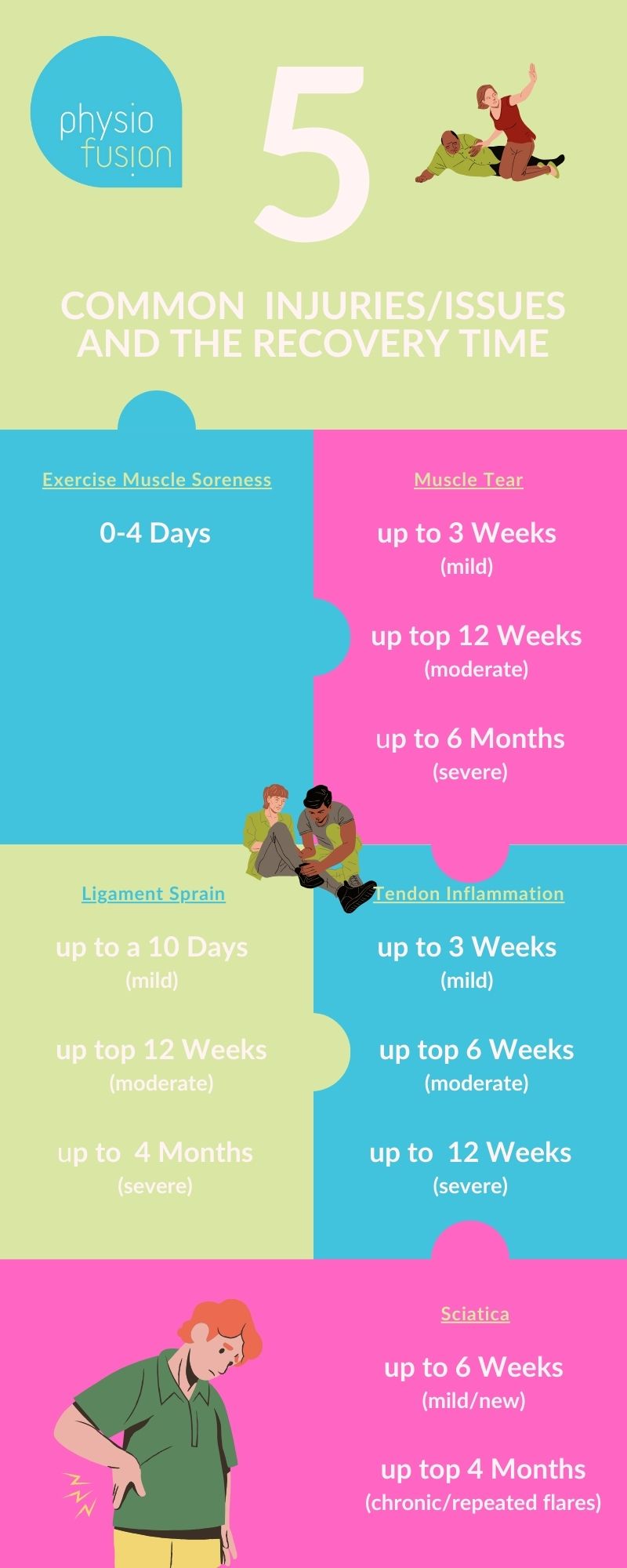News & Advice
Injury Recovery Time Infographic
Our latest injury recovery time infographic shows the five most common injuries we see and highlight the average length of time recovery is depending on the severity of the issue.
Call 01282 453 110 to book your appointment.

This injury recovery time infographic will be particularly helpful for those of us that are particularly physical or active. Whether we’re a seasoned athlete or a weekend warrior, strains, sprains, and other common injuries can occur when we least expect them. While it’s tempting to brush off minor discomfort or “play through the pain,” doing so can lead to more serious consequences down the road.
-
Muscle Soreness
This isn’t generally anything to worry about, however, prolonged muscle soreness could mean an underlying issue. Our muscles are usually sore for a reason, often from overworking them or trying a new exercise.
-
Ligament Sprains
These are among the most common injuries, often occurring due to overstretching or overexertion of muscles and ligaments. While they may seem minor initially, untreated sprains and strains can result in chronic pain, limited mobility, and even long-term joint damage.
-
Muscle Tears:
Muscle tears again can sounds worse than they are. For example, when we lift heavy weights for a certain amount of time, our muscle can be tender to touch. This is because our muscle tears and then re-grows all the time. This is completely normal when building muscle and is only very minimal tearing. However, there are cases when our muscle tears are more serious and need attention as soon as possible.
-
Tendon Inflammation:
Tendonitis, inflammation of the tendons usually caused by repetitive motion or overuse, can significantly impede daily activities and sports performance if left untreated. Early intervention with rest, ice, and physical therapy can prevent the condition from worsening and restore tendon health.
-
Sciatica:
Sciatica can seemingly come from nowhere and at times, completely debilitate us. The sciatic nerve starts just outside the base of our spine (lumbar spine and sacral region). It runs through the top of our gluteus muscles (bum) and down the back of our thighs (hamstrings) and lower legs (calves). That’s quite a significant area that we can experience pain. It’s quite common that where we feel pain isn’t actually where the issue is, so it’s vital you seek a therapist to help locate and treat it as soon as possible.
The benefits of early intervention?
-
Reduced Severity:
Nipping an injury in the bud can prevent it from escalating into a more serious condition. Early intervention allows therapists to address the issue before it worsens, potentially sparing us from prolonged pain and discomfort.
-
Minimised Treatment:
Treating an injury in its early stages often requires simpler and less invasive interventions. By seeking prompt help, me may avoid the need for extensive procedures or surgeries down the line, saving us time, money, and potential complications.
-
Quicker Healing Time:
The sooner we start treatment, the sooner our body can begin the healing process. Addressing an injury promptly can kickstart rehabilitation efforts, promoting tissue repair, and restoring function at a faster rate. This means less time spent side-lined and more time doing what you love.
-
Enhanced Long-Term Outcomes:
By prioritising early treatment, we set the stage for a more successful recovery and improved long-term outcomes. Taking proactive steps to address an injury demonstrates a commitment to our well-being, setting us up for a smoother transition back to our regular activities.
In essence, treating an injury as early as possible is a proactive approach that pays in the long run. Whether it’s seeking professional therapy, implementing home exercises, or modifying activity levels, taking swift action can make all the difference in our recovery journey. Remember, our health and well-being are worth prioritising, so don’t delay in addressing any signs of injury or discomfort.
For personalised guidance on injury treatment and rehabilitation, use our FREE Ask A Physio advice service to see how we can help you today.